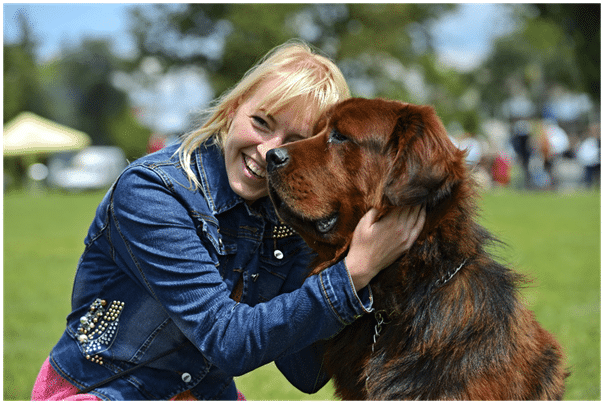The Tibetan Mastiff is known for its impressive size and strength, but is it also intelligent?
Tibetan Mastiffs are moderately intelligent dogs that are very intuitive to those around them. While they are considered hard to train due to their stubbornness and independence, they need little attention and make great companions for families.
We explore how intelligence can impact your dog’s behavior, and review how their emotional intelligence and body language are used to communicate with others.
How can you tell if a dog is intelligent?
Some people might say that you can tell by how well the dog performs on obedience tests or how quickly the dog learns new tricks.
Others might say that you can tell by how much the dog barks or how often the dog gets into trouble.
One way to determine how intelligent a Tibetan Mastiff is, is to look at how the dog interacts with people. Tibetan Mastiffs are known for being gentle giants – they’re not likely to bark excessively or get into trouble.
But that doesn’t mean they aren’t intelligent. In fact, many experts believe that Tibetan Mastiffs are some of the smartest dogs around.
There are a few things that set Tibetan Mastiffs apart from other dogs. For one, they’re very intuitive – they can sense when their owner is sad or upset, and they’ll do everything they can to comfort them.
They’re also very loyal, which is likely why they were originally bred as guard dogs.
And finally, Tibetan Mastiffs are very independent – they’re not the type of dog that needs constant attention and can be content spending time alone.
So, if you’re looking for an intelligent dog that will be a loyal companion, a Tibetan Mastiff might be the perfect fit for you!
What is the average IQ of a dog?
Estimates put the average IQ of a dog at around 100. This means that they are generally not as intelligent as humans but do have some ability to learn and understand commands.
Renowned canine researcher Standley Coren PhD reports that the average dog’s intelligence is on par with a two-year-old human.
He also identified that the average dog can learn around 165 words, whereas super dogs could learn up to 250 words!
Dogs are still able to perform many tasks and tricks that require a certain amount of intelligence and problem-solving ability.
So, while their IQ might not be as high as ours, they still have some impressive mental abilities.
How can I increase my dog’s intelligence?

There are a few ways that you can increase your dog’s intelligence. One way is to provide them with plenty of mental stimulation and moderate exercise.
This can include playing fetch or Frisbee, taking them for long walks, and providing them with lots of new toys to play with.
You can also challenge your dog mentally by teaching them new tricks or commands. Dogs love to learn and will quickly pick up new things.
Finally, make sure your dog is getting enough good-quality food. A nutritious diet is essential for overall health and can also help improve brain function.
If you follow these tips, you should see a noticeable difference in your dog’s intelligence and overall well-being.
Are Tibetan Mastiffs hard to train?
The Tibetan Mastiff breed is known for being one of the most difficult dog breeds to train. They are highly independent and can be quite stubborn.
They also have a strong prey drive, which means they may be inclined to chase small animals. However, with proper training and patience, it is possible to create a well-behaved Tibetan Mastiff.
In conjunction with training, puppy socialization classes will also benefit your Tibetan mastiff. Early exposure to other puppies will be of huge benefit, and will likely reduce the risk of undesirable and aggressive behaviors.
As Tibetan Mastiffs are generally quite territorial, intensive socialization is a must. Considering their enormous size, you don’t want them becoming aggressive with other dogs and people as this can be very difficult to manage.
What’s the hardest dog to train?
Experts believe that the hardest dogs to train are those that are naturally independent and have a strong will. These dogs can be difficult to motivate and may be resistant to traditional training methods.
Other dogs that may be difficult to train include those that are easily distracted, have a lot of energy or are very stubborn. Training these dogs requires patience, creative thinking, and a lot of positive reinforcement.
Some of the hardest dog breeds to train include the Afghan Hound, Australian Cattle Dog, Basset Hound, Beagle, Bulldog, Chow Chow, Cocker Spaniel, Dachshund, Norwegian Elkhound, and the Shih Tzu.
Dogs that are mixed with one of these breeds may also be difficult to train.
If you’re thinking about getting a dog, it’s important to do your research to make sure you’re getting a breed that will be a good fit for your lifestyle and personality.
Training and careful socialization are important aspects of owning a dog, so be prepared to put in the time and effort if you want to have a well-behaved pet.
Is the Tibetan Mastiffs emotionally intelligent?

A study published in the journal “Behavioural Processes” suggests that the Tibetan Mastiff may be emotionally intelligent.
The study found that when given the choice between interacting with a human or an object, the dogs preferred to interact with the human.
This suggests that they have a strong ability to empathize and communicate with humans.
This isn’t the first study to suggest that Tibetan Mastiffs have high emotional intelligence. Previous studies have shown that they are very good at reading human body language and emotions.
They are also known for being very protective of their owners and being able to sense when something is wrong.
You may also like – Can a Tibetan Mastiff Be a Service Dog?
How do you know if your dog is emotionally intelligent?
The emotional intelligence of dogs can vary depending on their breed, personality, and life experiences.
However, there are some signs that you can look out for if you want to know whether your dog is emotionally intelligent.
Additionally, if your dog is able to respond appropriately to your emotions, such as comforting you when you are sad or being playful when you are happy, this is also an indication of emotional intelligence.
Another way to tell if your dog is emotionally intelligent is by its behavior around other people and animals.
If your dog is friendly and outgoing with both people and other animals, this is a good sign that they are emotionally intelligent.
Conversely, if your dog tends to be aggressive or shy around other people and animals, this may be a sign that they are not as emotionally intelligent as other dogs.
Overall, if your dog exhibits a number of the behaviors listed above, it is likely that they are emotionally intelligent. If your dog does not exhibit any of these behaviors, this does not mean that they lack emotional intelligence, and it may be something to keep an eye on.
How can I tell if my dog has mental problems?
Signs that your dog may have mental problems include certain changes in behavior. This may include increased aggression or lethargy, refusal to eat, or excessive barking.
If you notice any of these changes in your dog’s behavior, it is important to take him to the vet for a check-up.
The vet will be able to rule out any physical causes for the changes in behavior. If necessary, they may refer you to a veterinary behaviorist or animal psychologist. This can be a good option that can help your dog deal with his mental issues.
Are dogs that watch television smart?
Some people believe that dogs who watch television are smart. This is because they are learning and reacting to what is happening on the screen.
Others believe that this isn’t so true. They believe the only thing the dog is doing is mimicking what it sees.
There is not a lot of scientific evidence to support either side of this argument, so it is hard to say for sure. However, it is possible that dogs who watch television may learn some things from the experience.
Can Tibetan Mastiffs read body language?
Yes, the Tibetan Mastiff is known to be very intuitive and intelligent enough to pick up on subtle cues in a person’s body language.
This makes them excellent at reading people and knowing when something is wrong or when someone is lying.
They are also good at detecting emotions in people, which include if someone is anxious, upset, or even angry.
This makes them great dogs for security or law enforcement, as they can often sense when something is about to happen before it does.
They are also very good at understanding commands and instructions, even if they are only given verbally.
How do Tibetan Mastiffs communicate through body language?

Tibetan Mastiffs use body language to communicate with other dogs, as well as with their owners. They use a variety of facial expressions, postures, and signals to communicate their feelings and intentions.
Wagging of the Tail
For example, a Tibetan Mastiff who is wagging his tail and licking his lips may be trying to say “I’m friendly” to another dog or person.
You will likely encounter this behavior just before you take your dog on their daily walks.
Baring of Teeth
A Tibetan Mastiff who is baring his teeth may be trying to say “I’m angry” or “I’m scared.” Owners can learn to interpret these signals to better understand what their dog is trying to say.
Altered Posture
The posture of a Tibetan Mastiff can also be a clue to his feelings. A Tibetan Mastiff who is standing tall and proud may be feeling confident. While a Tibetan Mastiff who is cowering or hiding may be feeling scared or submissive.
Raised Hackles
A Tibetan Mastiff’s hackles may also be raised to indicate that he is feeling threatened or aggressive. Be mindful if you see a dog with its hackles raised. It is best to give him some space and avoid approaching him.
Many of the facial expressions and postures of a Tibetan Mastiff are similar to those of human beings. So people can often understand what a Tibetan Mastiff is trying to say just by looking at his face.
The Tibetan Mastiff is a very expressive dog, which is often an extension of how intelligent they really are.
Owners can learn a lot about their Tibetan Mastiff by paying attention to their body language.
By understanding what their dog is trying to say, owners can provide the appropriate response. This can be reassurance, comfort, or simply backing off.


